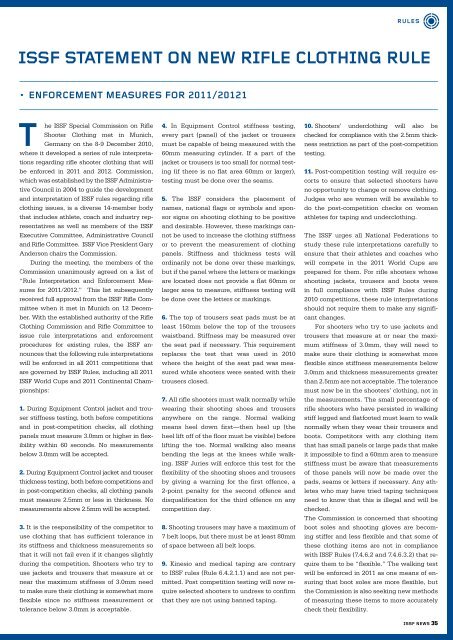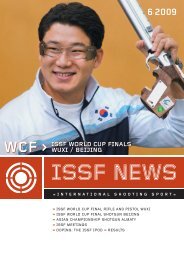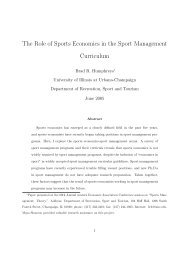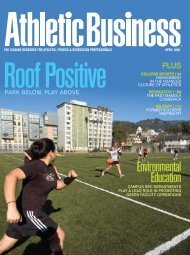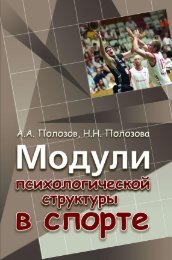Create successful ePaper yourself
Turn your PDF publications into a flip-book with our unique Google optimized e-Paper software.
T<br />
he ISSF Special Commission on Rifle<br />
Shooter Clothing met in Munich,<br />
Germany on the 8-9 December 2010,<br />
where it developed a series of rule interpretations<br />
regarding rifle shooter clothing that will<br />
be enforced in <strong>2011</strong> and 2012. Commission,<br />
which was established by the ISSF Administrative<br />
Council in 2004 to guide the development<br />
and interpretation of ISSF rules regarding rifle<br />
clothing issues, is a diverse 14-member body<br />
that includes athlete, coach and industry representatives<br />
as well as members of the ISSF<br />
Executive Committee, Administrative Council<br />
and Rifle Committee. ISSF Vice President Gary<br />
Anderson chairs the Commission.<br />
During the meeting, the members of the<br />
Commission unanimously agreed on a list of<br />
“Rule <strong>In</strong>terpretation and Enforcement Measures<br />
for <strong>2011</strong>/2012.” This list subsequently<br />
received full approval from the ISSF Rifle Committee<br />
when it met in Munich on 12 December.<br />
With the established authority of the Rifle<br />
Clothing Commission and Rifle Committee to<br />
issue rule interpretations and enforcement<br />
procedures for existing rules, the ISSF announces<br />
that the following rule interpretations<br />
will be enforced in all <strong>2011</strong> competitions that<br />
are governed by ISSF Rules, including all <strong>2011</strong><br />
ISSF World Cups and <strong>2011</strong> Continental Championships:<br />
RULES<br />
ISSF STATEMENT ON NEW RIFLE CLOTHING RULE<br />
• ENFORCEMENT MEASURES FOR <strong>2011</strong>/20121<br />
1. During Equipment Control jacket and trouser<br />
stiffness testing, both before competitions<br />
and in post-competition checks, all clothing<br />
panels must measure 3.0mm or higher in flexibility<br />
within 60 seconds. No measurements<br />
below 3.0mm will be accepted.<br />
2. During Equipment Control jacket and trouser<br />
thickness testing, both before competitions and<br />
in post-competition checks, all clothing panels<br />
must measure 2.5mm or less in thickness. No<br />
measurements above 2.5mm will be accepted.<br />
3. It is the responsibility of the competitor to<br />
use clothing that has sufficient tolerance in<br />
its stiffness and thickness measurements so<br />
that it will not fail even if it changes slightly<br />
during the competition. Shooters who try to<br />
use jackets and trousers that measure at or<br />
near the maximum stiffness of 3.0mm need<br />
to make sure their clothing is somewhat more<br />
flexible since no stiffness measurement or<br />
tolerance below 3.0mm is acceptable.<br />
4. <strong>In</strong> Equipment Control stiffness testing,<br />
every part (panel) of the jacket or trousers<br />
must be capable of being measured with the<br />
60mm measuring cylinder. If a part of the<br />
jacket or trousers is too small for normal testing<br />
(if there is no flat area 60mm or larger),<br />
testing must be done over the seams.<br />
5. The ISSF considers the placement of<br />
names, national flags or symbols and sponsor<br />
signs on shooting clothing to be positive<br />
and desirable. However, these markings cannot<br />
be used to increase the clothing stiffness<br />
or to prevent the measurement of clothing<br />
panels. Stiffness and thickness tests will<br />
ordinarily not be done over these markings,<br />
but if the panel where the letters or markings<br />
are located does not provide a flat 60mm or<br />
larger area to measure, stiffness testing will<br />
be done over the letters or markings.<br />
6. The top of trousers seat pads must be at<br />
least 150mm below the top of the trousers<br />
waistband. Stiffness may be measured over<br />
the seat pad if necessary. This requirement<br />
replaces the test that was used in 2010<br />
where the height of the seat pad was measured<br />
while shooters were seated with their<br />
trousers closed.<br />
7. All rifle shooters must walk normally while<br />
wearing their shooting shoes and trousers<br />
anywhere on the range. Normal walking<br />
means heel down first—then heel up (the<br />
heel lift off of the floor must be visible) before<br />
lifting the toe. Normal walking also means<br />
bending the legs at the knees while walking.<br />
ISSF Juries will enforce this test for the<br />
flexibility of the shooting shoes and trousers<br />
by giving a warning for the first offence, a<br />
2-point penalty for the second offence and<br />
disqualification for the third offence on any<br />
competition day.<br />
8. Shooting trousers may have a maximum of<br />
7 belt loops, but there must be at least 80mm<br />
of space between all belt loops.<br />
9. Kinesio and medical taping are contrary<br />
to ISSF rules (Rule 6.4.2.1.1) and are not permitted.<br />
Post competition testing will now require<br />
selected shooters to undress to confirm<br />
that they are not using banned taping.<br />
10. Shooters’ underclothing will also be<br />
checked for compliance with the 2.5mm thickness<br />
restriction as part of the post-competition<br />
testing.<br />
11. Post-competition testing will require escorts<br />
to ensure that selected shooters have<br />
no opportunity to change or remove clothing.<br />
Judges who are women will be available to<br />
do the post-competition checks on women<br />
athletes for taping and underclothing.<br />
The ISSF urges all National Federations to<br />
study these rule interpretations carefully to<br />
ensure that their athletes and coaches who<br />
will compete in the <strong>2011</strong> World Cups are<br />
prepared for them. For rifle shooters whose<br />
shooting jackets, trousers and boots were<br />
in full compliance with ISSF Rules during<br />
2010 competitions, these rule interpretations<br />
should not require them to make any significant<br />
changes.<br />
For shooters who try to use jackets and<br />
trousers that measure at or near the maximum<br />
stiffness of 3.0mm, they will need to<br />
make sure their clothing is somewhat more<br />
flexible since stiffness measurements below<br />
3.0mm and thickness measurements greater<br />
than 2.5mm are not acceptable. The tolerance<br />
must now be in the shooters’ clothing, not in<br />
the measurements. The small percentage of<br />
rifle shooters who have persisted in walking<br />
stiff legged and flatfooted must learn to walk<br />
normally when they wear their trousers and<br />
boots. Competitors with any clothing item<br />
that has small panels or large pads that make<br />
it impossible to find a 60mm area to measure<br />
stiffness must be aware that measurements<br />
of those panels will now be made over the<br />
pads, seams or letters if necessary. Any athletes<br />
who may have tried taping techniques<br />
need to know that this is illegal and will be<br />
checked.<br />
The Commission is concerned that shooting<br />
boot soles and shooting gloves are becoming<br />
stiffer and less flexible and that some of<br />
these clothing items are not in compliance<br />
with ISSF Rules (7.4.6.2 and 7.4.6.3.2) that require<br />
them to be “flexible.” The walking test<br />
will be enforced in <strong>2011</strong> as one means of ensuring<br />
that boot soles are more flexible, but<br />
the Commission is also seeking new methods<br />
of measuring these items to more accurately<br />
check their flexibility.<br />
ISSF NEWS 35


